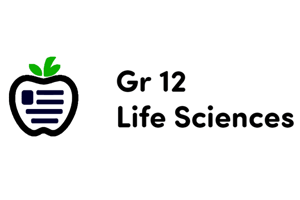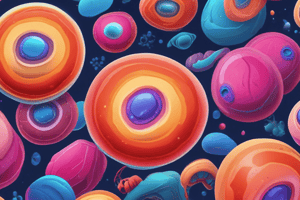Podcast
Questions and Answers
Flashcards
What are gametes?
What are gametes?
Sex cells (egg cells and sperm cells), also known as spores.
What are somatic cells?
What are somatic cells?
All the cells in your body that are not sex cells. They make up most of your body's tissues and organs and their DNA is NOT passed to offspring.
What are germ cells?
What are germ cells?
Cells in your reproductive organs (ovaries or testes) that develop into eggs or sperm (gametes).
What are homologous chromosomes?
What are homologous chromosomes?
Signup and view all the flashcards
What are autosomal chromosomes?
What are autosomal chromosomes?
Signup and view all the flashcards
What are sex chromosomes?
What are sex chromosomes?
Signup and view all the flashcards
What are diploid cells?
What are diploid cells?
Signup and view all the flashcards
What are haploid cells?
What are haploid cells?
Signup and view all the flashcards
What is mitosis?
What is mitosis?
Signup and view all the flashcards
What is meiosis?
What is meiosis?
Signup and view all the flashcards
What is crossing over?
What is crossing over?
Signup and view all the flashcards
What is spermatogenesis?
What is spermatogenesis?
Signup and view all the flashcards
What is oogenesis?
What is oogenesis?
Signup and view all the flashcards
What is independent assortment?
What is independent assortment?
Signup and view all the flashcards
What are linked genes?
What are linked genes?
Signup and view all the flashcards
Study Notes
- Gametes, also known as sex cells (egg and sperm cells), and spores.
- Somatic cells, or body cells, comprise most of the body's tissues and organs.
- Somatic cell DNA is not passed to offspring.
- Germ cells, located in reproductive organs (ovaries or testes), develop into gametes.
- Germ cell DNA is passed to offspring.
- Homologous chromosomes are two chromosomes, one from each parent, that are the same size and have copies of the same genes.
- Each species has a characteristic number of chromosomes per cell, usually given for body cells.
- The first 22 pairs of chromosomes are autosomal.
- Sex chromosomes (X and Y) determine gender in mammals.
- Fertilization occurs between egg and sperm in sexual reproduction.
- Body cells are diploid.
- Gametes are haploid.
- Gametes have 22 autosomes and 1 sex chromosome.
Mitosis vs. Meiosis
- Mitosis produces genetically identical diploid cells, takes place throughout an organism's lifetime, and is involved in asexual reproduction.
- Meiosis produces genetically unique haploid cells, takes place at certain times in an organism's life cycle, and is involved in sexual reproduction.
Meiosis Overview
- Meiosis starts with a diploid germ cell that has undergone DNA replication.
- Meiosis involves one DNA replication followed by two cell divisions, resulting in four haploid cells.
- Meiosis is a form of nuclear division that creates four haploid cells from one diploid cell.
- Each round of meiosis (Meiosis I and II) has four phases.
- Homologous chromosome pairs separate in Meiosis I.
- Sister chromatids divide in Meiosis II.
- Sister chromatids are copies of the same chromosome.
Meiosis I Stages
- Prophase I: The nuclear membrane breaks down, chromosomes condense, and homologous chromosomes pair up, where crossing over occurs.
- Metaphase I: Chromosomes line up along the middle of the cell.
- Anaphase I: Homologous chromosomes separate, while sister chromatids remain attached.
- Telophase I: Cytokinesis separates the cells, resulting in haploid cells with duplicated chromosomes.
- Meiosis I separates homologous chromosome pairs.
Meiosis II Stages
- Prophase II: The nuclear membrane breaks down, and cells prepare to divide.
- Metaphase II: Chromosomes line up along the middle of the cell.
- Anaphase II: Sister chromatids separate and move to opposite sides of the cell.
- Telophase II: Nuclear membranes form again, resulting in four haploid cells with a combination of chromosomes from both parents.
- DNA is not replicated between Meiosis I and II.
- In Anaphase I, sister chromatids stay together.
Gametogenesis
- Gametogenesis is the production of gametes; it differs between females and males.
- Spermatogenesis results in four sperm cells.
- Oogenesis results in one egg cell and polar bodies, which are smaller cells that contain little more than DNA and are eventually broken down.
- The haploid cells resulting from meiosis require further changes to form mature gametes capable of fertilization.
Genetic Diversity Factors
- Independent assortment, crossing over, and random fertilization contribute to genetic diversity.
- A major advantage of sexual reproduction is the genetic variation within a species.
- There are about 8 million (2^23) combinations of chromosomes that can be produced through meiosis from one human cell due to 23 chromosomes in haploid cells.
- Random fertilization of gametes yields over 70 trillion (2^23 x 2^23) different combinations.
- Independent assortment describes how chromosomes assort independently of one another during gamete formation.
- Unique phenotypes may give a reproductive advantage to some organisms.
- Phenotype refers to the physical appearance of a trait.
Crossing Over & Genetic Linkage
- Crossing over exchanges chromosome segments between homologous chromosomes. Resulting in genetic recombination, mixing parental alleles.
- Alleles are representations of a gene.
- Crossing over occurs in Prophase I of Meiosis I.
- Closer genes are more likely to be inherited together.
- Linked genes (genetic linkage) are genes on the same chromosome located close to each other.
- Chromosomes contain many genes.
- The farther apart two genes are on a chromosome, the more likely they are to be separated by crossing over and independent assortment.
- Genetic linkage allows calculation of the distance between two genes.
Studying That Suits You
Use AI to generate personalized quizzes and flashcards to suit your learning preferences.




